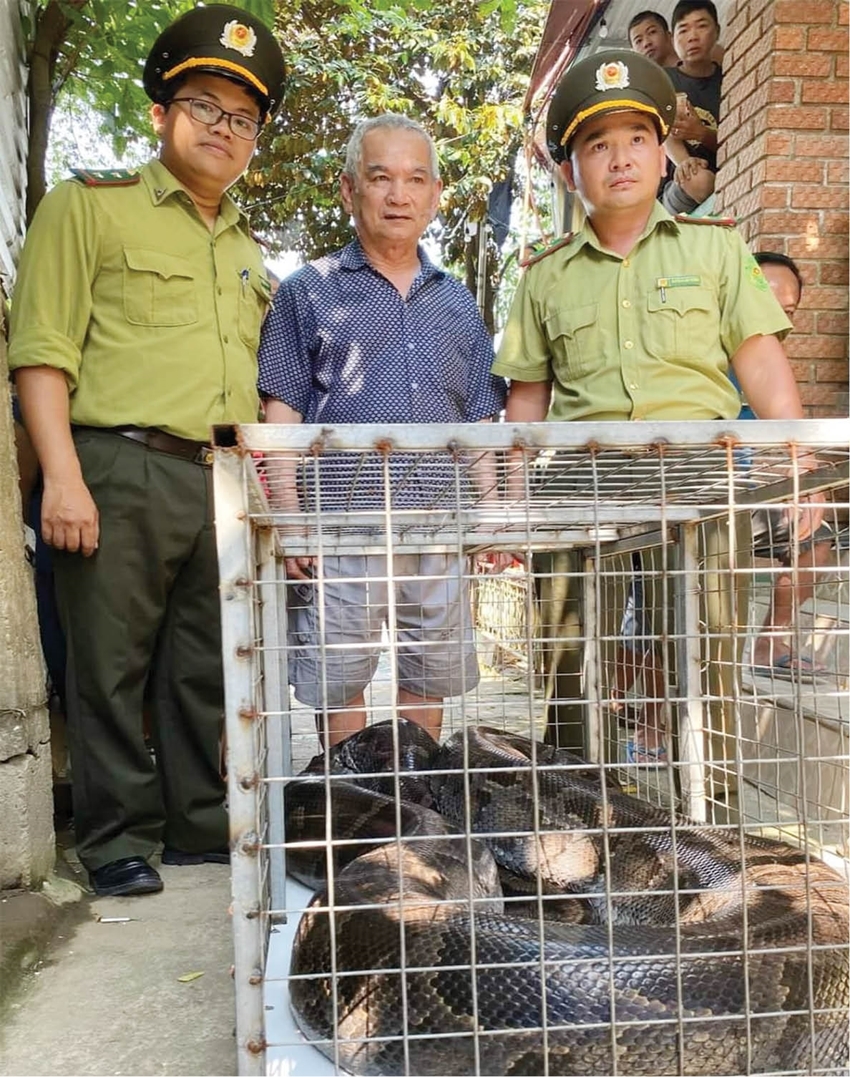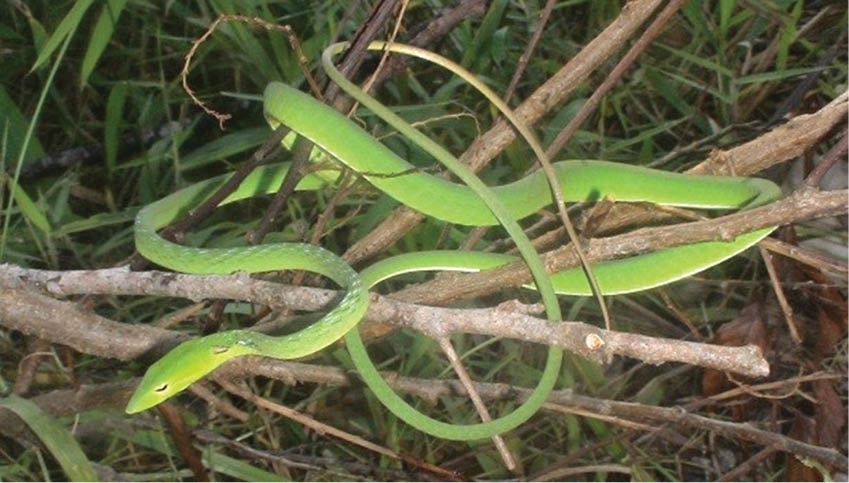 |
| Forest rangers receiving a rare python |
A fondness for… snakes
Mr. Tran Xuan Hai, Deputy Director of Phong Dien Nature Reserve Management Board, developed his love for nature’s beauty and wildlife conservation from a young age, back when he was still a student. During the season when flocks of bird migrated to nest and reproduce, his classmates would often equip themselves with slingshots to hunt these animals. On such occasions, Mr. Hai would step in to discourage his friends from doing such actions. Perhaps, his passion for wildlife began at that very moment.
Being recruited to work at Phong Dien Nature Reserve felt like fate for Mr. Hai. Deep down, his love for all wildlife animals was the same, but snakes were among the creatures tied to many memories from his school days.
Mr. Hai recounts how he, as a child, often heard people say encountering a grass snake (a harmless species of snake) was a sign of good luck and academic success. Though purely coincidental, the belief became stronger among school children like him, especially when they performed well in their studies after such encounters. This childhood superstition gradually deepened his love for animals, particularly snakes. Mr. Hai once fought back tears when he saw snake dishes being served and jars of liquor infused with these reptiles.
To him, snakes, as well as any other wildlife species, have maternal instincts and deep bonds with their mates. As a child, he once witnessed extremely touching scenes when a mother snake fiercely protected her young from a group of sewer rats searching for food. She coiled around her offspring, shielding them from danger while bravely fighting off the predators. On another occasion, he saw a pair of “husband-and-wife” snakes entwined, refusing to be separated even as a torrential flood raged around them in a rushing stream.
Mr. Tran Xuan Hai once suggested that authorities and conservation units placed more emphasis on searching and preserving snake species. During patrols and mobile awareness campaigns, he and the staff members working in conservation always bring along images of different snake species, especially those of rare and endangered ones. At community meetings, they showcase these images to help locals identify, understand, and join hands with functional units in conservation efforts.
 |
| White-lipped pit viper in Phong Dien Nature Reserve |
Mr. Hai shares that in recent years, efforts to protect and conserve snake species have gained more attention, leading to positive changes in public awareness. Snake-infused liquor jars have become less common in restaurants and eateries. However, in some areas, especially among local communities living near forests and lagoons, people still secretly poach snakes for food or for sale to restaurants. “If this kind of exploitation still persists, many snake species will decline in number and face the risk of extinction,” warns Mr. Hai.
Conservation efforts
Thua Thien Hue (now Hue City) boasts a rich ecosystem with approximately 50 recorded snake species, including many endemic ones. Interestingly, a new species of snake, named Bach Ma Green Rat Snake (ptyas bachmaensis), was recently discovered in Bach Ma mountain. This finding not only highlights the region’s incredible biodiversity but also provides new opportunities for wildlife conservation efforts in the area.
According to Mr. Le Ngoc Tuan, Director of the City’s Forest Protection Department, Hue faces numerous challenges in conserving snake species. Several species, including pit vipers (Trimeresurus spp) and cobras (Naja spp), are under alarming threat. A study by the Institute of Ecology and Biological Resources found that viper populations in natural forests had declined by more than 40% over the past 20 years due to deforestation and urbanization. This decline raises significant concerns about the survival of these species and the ecological balance of the region.
Habitat loss remains one of the biggest threats to snake conservation in Hue. Urban expansion and population growth have led to increased infrastructure development, placing immense pressure on natural habitats. Forests, wetlands, and swamps, ideal environments for many snake species, are gradually being replaced by residential buildings, commercial areas, and large-scale development projects.
 |
| Oriental whip snake in Phong Dien Nature Reserve |
The poaching of snakes for use in traditional medicine and as food not only puts tremendous pressure on snake populations but also leads to a decline in biodiversity in the region, severely impacting the ecosystems where they live. Furthermore, climate change is adding additional stress to natural habitats. Habitat loss is not just an issue for snake species; it affects the entire ecosystem, threatening the ecological balance.
According to Mr. Le Ngoc Tuan, in response to these growing concerns, Hue has implemented various programs to conserve snake species and their natural habitats. One key initiative is the preservation and expansion of natural forest ecosystems in Bach Ma National Park and Phong Dien Nature Reserve, along with the increased patrols and stronger enforcement of wildlife protection laws in safeguarding wildlife animals in general and snakes in particular.
The city’s forest rangers have been actively involved in protecting snake species. In 2024 alone, they received and rescued two reticulated pythons (malayopython reticulatus) and two carpet pythons (morelia spilota) that were voluntarily handed by local residents. These species are classified as endangered, precious, and rare under Group IIB of the forest animal species list. Although these pythons are not yet critically endangered, they face the risk of being threatened if not strictly managed, with limited exploitation for commercial purposes. Both snakes were cared for and then released back into their natural habitat, contributing to the restoration of local snake and python populations. These actions not only help protect snake species but also encourage a sense of responsibility within the community for wildlife conservation.
Community outreach and educational activities have been actively implemented by the forest protection department, reaching out to every neighborhood and household. Non-governmental organizations (NGOs) and local authorities have organized numerous workshops and educational programs to raise awareness among the public about the importance of snakes in the ecosystem. These communication campaigns have helped reduce people’s fear of snakes, thence encouraging them to participate in their protection. The conservation of snake species is not only the responsibility of the government but also requires the active involvement and action of every individual.
|
|
| According to experts, Phong Dien Nature Reserve is home to 88 amphibian and reptile species, with 20 snake species belonging to 3 different families. According to species composition studies of Phong Dien Nature Reserve, Vietnam’s Red Book (2007) and Decree 84/2021/NĐ-CP, a total of 24 amphibian and reptile species in the reserve have been identified as endangered or threatened. This includes two amphibian species and 22 reptile species, each facing varying levels of risk. |